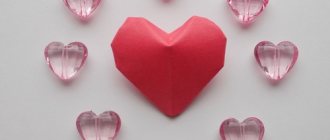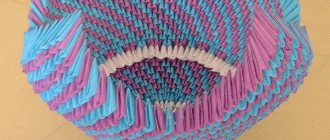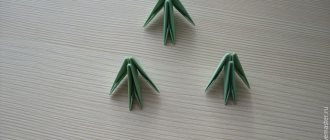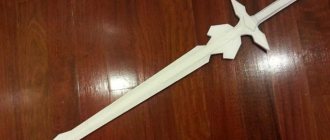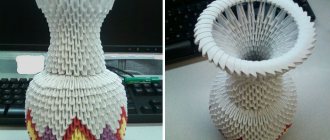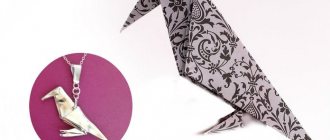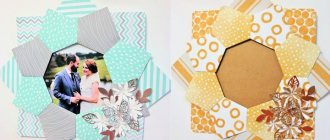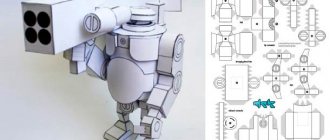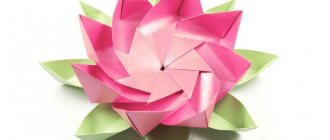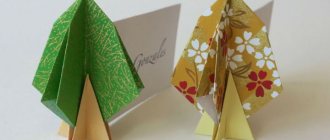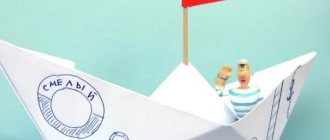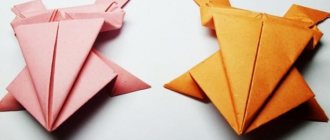A figurine of a dolphin, including one made using the origami technique, can be used as a talisman. Among the inhabitants of the Mediterranean, these animals were considered protectors of sailors and everyone who travels on water. And in the east, pairs of paper dolphins were connected into pendants to attract happiness, love and good luck to the house. There are several simple origami models that can be folded in a few minutes and are accessible to beginners. Even if the dolphin figurine does not affect our destiny in any way, it will definitely give us a good mood, which is already a lot.
Step-by-step making of papercraft dolphin from paper for beginners
Step 1. Print the blanks on a printer and number all the parts. If there is no numbering on the diagrams, do it yourself, relying on a computer model. This will save time in the future, especially when assembling large structures.
The solid line in the diagram indicates the location of the cut, the dotted line indicates the inner fold (on models without texture), and on textured models the outer fold. Dash-and-dotted is the opposite: with textured ones inward, without texture - outward.
Cut out carefully, leaving margins for gluing, thanks to which the individual parts of the model will fit together.
Step 2. All folds are worked out in detail along the dotted lines. On the outside, glue is applied to the bent strip or double-sided tape is applied. When working with the latter you should be extremely careful. If glue is used, each connection is allowed to dry thoroughly and only then proceed to attaching the next element. Make sure that all joints match perfectly, since the appearance of the finished product depends on this.
When connecting internal elements through a small hole, tweezers are used (relevant in the final stages). Do not forget to insert several spacers inside the structure, because volumetric modeling does not provide for the presence of a frame, and paper, as you know, tends to crumple even under weak force.
In the event that the entire structure is made from whatman paper, but some parts need to be painted in the desired color, use thick gouache.
Step 3. The finished model is pasted onto the canvas (on the wall), placed on a stand, or hung.
Video of the finished 3D model:
Video tutorial on how to make a dolphin from Minecraft for beginners:
Examples of models and developments for them
Small dolphins assembled according to a simple pattern
Unwrapping of a small dolphin.
Killer whale.
Ream to whale/killer whale
Dolphin 3D.
Development of a 3D dolphin (indicating the fields for gluing).
Intellectual Teddy
To add a gentleman to your collection of soft toys, you will need:
- sketch;
- paper;
- scissors;
- pen-pencil;
- fabric in two shades;
- sewing pins;
- needle;
- padding polyester, cotton wool, etc.;
Attention! Before you pick up a needle or cut out an abstract shape, imagine how the toy will look in the end. Awareness of what is happening gives the character texture, character and its own so-called “highlights”
Formulate a thought and put your soul into it so that the product becomes a personality. For example, gentleman Teddy is well-mannered, sociable, and romantic. Friendly, responsive, always ready to lend a helping hand.
Imagine how you would like to see Teddy. For example, stand? Sit or keep surprise? Accordingly, we find approximately the same sketch, which we pin to the edge of the canvas to avoid unnecessary waste.
We outline the outline. We cut out the common part in two copies. To prevent our man from shrinking in size, leave 0.5 cm on all sides; Using a sewing machine, sew along the drawn outline.
Now we turn the bear inside out; the presence of Chinese roll sticks simplifies the task. We fill it with filler, then use a needle to sew the hole up imperceptibly.
If desired, you can paint facial expressions with acrylic paints or glue on eyes, which are sold in any craft store. We embroider the nose and mouth with black thread.
Sew a bow tie and tie the teddy bear around the neck. If you wish, you can easily insert a Valentine card.
It will be more difficult to make Teddy more textured, paying attention to every detail. Unlike the previous option, here everything is cut out separately, including the muzzle, four legs and, say, the heart
The base will need terry, soft and fluffy, which is usually used for plush toys, and the seams can be done by hand; you can easily put the sewing machine aside.
The reason for this is the literal sewing of some parts into others. For example, one heart is sewn with a loop stitch inside another. As a result, the volume and bulge of the same paws or tiny tail at the back.
Master class on the topic: how to sew a dolphin from felt with your own hands
To work you will need:
- blue and light blue felt
- thin blue thread
- needle
- stuffing material
- two black beads
- scissors
Print or redraw the dolphin pattern. Cut out its details. Using a pattern, we cut out the dolphin parts from felt without seam allowances.
- Part No. 1 – made of blue felt – 1 pc.
- Part No. 2 – blue felt – 1 pc.
- Part No. 3 – blue felt – 2 pcs. in a mirror image.
We will sew a dolphin from felt. Felt is an excellent material for making toys with your own hands. It is not necessary to use this exact blue-blue combination; for work you can use felt in other colors - purple, gray, dark green. The main thing is to choose contrasting colors. If you don't have felt, you can use fleece or fabric.
Choose the size of the dolphin as you wish. The length of my dolphin was 9 cm.
We sew two parts No. 3 of the blue felt back of the dolphin together using an overcast stitch, as shown in the photo:
We sew the muzzle to the resulting back of the dolphin - part No. 2 from the inside with a seam “over the edge”.
We sew the dolphin’s belly from blue felt with an overcast stitch – part No. 1. We leave enough unstitched space on the dolphin’s side to stuff it.
We stuff the dolphin with stuffing material and sew up the hole. As a material for stuffing a dolphin, you can use synthetic polyester or cotton wool.
Sew on the dolphin's eyes using black beads.
This is the final felt dolphin toy:
If you enlarge the dolphin pattern several times, you can sew a pillow with your own hands in the shape of a dolphin, which will perfectly complement the summer interior.
Author - Nadezhda Bogomolova especially for the Samoshveyk website
Birdie
Previously, this toy was considered amulets for children. Such things were made with their own hands from the simplest materials found at home. Make your own amulet of happiness!
Take any square piece of beautiful fabric, filler, and monochrome thread.
- Fold the piece diagonally and form a beak at the tip of one of the sharp corners, wrap it with thread 2 times, secure without breaking the thread.
- Unfold the folded piece and stuff cotton wool into the dimple near the key; this will be the head.
- Fold it diagonally again, wrap it 2 times (that’s the magic), secure it. Cut the thread, leaving 30-40 cm.
- Thread the thread into the needle and stitch along the diagonal fold, not reaching the very edge 5-7 cm. Pull and see what happens - these are the wings of the tail! Fasten in a way convenient for you, decorate your amulet to your taste.
Filling the dolphin balancer with solder
Before filling with solder, in the place where the dolphin balancer is attached to the fishing line, I punch a hole in the thin-walled shell, insert the tinned ends of the fastening loop, bend them from the inside to the sides, and wrap the loop around the outside with thread, eliminating the gap between the hole and the loop.
I place the homemade balancer blank into the recess of a wooden block (Fig. 3), insert the tinned shank of the hook into the cavity and secure it, slightly driving the tip into the end of the block.
(Don’t forget to pierce a hole in the wood with a narrow screwdriver so that the fastening loop is recessed into the block before filling the crown with solder)
I lubricate the inside of the homemade balancer shell with flux containing acid, and fill the cavity in the dolphin crown with molten lead, babbitt or other solder. As it cools, I form a bulge along the entire length of the cavity.
After pouring, the outer surface of the dolphin balancer is processed with a file and polished. The blade is painted black with nitro enamel.
(If any of the fishermen do not quite understand the explanations of the author of the invention regarding filling the dolphin balancer with solder, I can offer my method of filling the crowns of sheer lures with solder to help.)
Easter Bunny Tilda
This toy is the most famous in its niche. The reason for its popularity is its simple level of complexity, which is quite within the capabilities of even novice needlewomen.
To create Tilda, we need:
- fabric (preferably cotton);
- scissors;
- filler;
- sewing machine;
- paper;
The Internet is replete with patterns for our future toy, so we choose any one and attach the parts to the fabric turned inside out. We cut it out, leaving 0.5 cm on the sides, after which we step by step sew the ears first, then take on the main body.
As in the previous stage, do not forget to insert the stitched parts of the ears from the inside in time. During sewing, the paws should be stuffed with filler, be it synthetic padding or just cotton wool. Don't forget to add a tack at the beginning and end.
We turn the workpiece inside out and tightly fill the empty space. We manually stitch Tilda's face with threads - eyes, eyelashes, rosy cheeks and mouth.
The final stage is the clothing pattern. As a rule, girls are invariably dressed in a dress decorated with openwork ribbons, and boys are dressed in a T-shirt/jacket and pants.
You will immediately feel the long-awaited relaxation and uplifting mood. For example, a hand-sewn cat pillow will provide warmth at night, and in the arms of a child, a plush toy will become protection from nightmares.
Making a cute dolphin from clay
Summer has flown by. It's time to do something that will remind you of this wonderful time. I want to save a piece of the warm sea and sun. A small dolphin, I think, would be suitable for this. If you already have experience working with clay, good. If not, don't worry. The master class is simple, you can make it together with your children. We will need a small lump of clay, a rolling pin, a smoothing iron, a piece of fabric, a pencil, a brush, a piece of paper and inspiration.
Let's make a sketch of our dolphin.
We make it a little wider, since it will narrow during the sculpting process.
Before starting work, lay a thick cloth on the table, fold it in half and preferably put on an apron. Clay is not a completely clean matter. Roll out the layer to approximately 7 mm thick.
We apply our dolphin blank and trace it on top with a pencil, pressing a little so that an imprint remains on the clay. We only outline the carcass. We'll do the fins, tail and everything else later.
Using the sharp end of the trowel, cut along the contour of the workpiece.
Now in each part we push the middle with our thumb to get volume. When making the second half, make sure that it mirrors the first and fits in size. You need to act quickly and carefully so that the clay does not dry out and tears form. This is how the halves turned out.
Before joining the halves, we make notches on the clay with the sharp edge of a trowel and lubricate it with slurry, here it plays the role of glue. Zhizhel is clay diluted with water to the state of sour cream.
Now we connect the halves. First we close the seams, as when making dumplings - one edge to the other with a pigtail, and then smooth it out. The result was a hollow blank.
It's time for the details. Cut out the muzzle, fins and tail. And connect it to the carcass. Don't forget to make notches and lubricate with liquid.
We smooth out the joints, achieving integrity. In the process, the tail and fins were reduced.
After that all that remains is to add the eyes and draw a smile.
Don't forget to make holes. They are necessary so that during firing the product does not tear and the thread can be inserted in the future. It is advisable to first find the center of gravity of the dolphin and make holes there. I have this place near the upper fin.
Now you need to put it in a dry place, without drafts, for three or four days to dry. Afterwards you can go over the uneven areas with sandpaper. We fire it in a muffle furnace to give it strength.
This is what happened in the end.
You can leave it like this, but I decided to decorate it using acrylic paints. First I primed it with white, and then let my imagination lead me.
Thank you for your attention to my master class. Source
Source
Finishing touches
Step 1
Now you have all the guide lines, so we just need to put the finishing lines on them. You can take a blank piece of paper and place it on top of the sketch if you are drawing traditionally. You can also try erasing most of the guide lines and darkening the ones you want to keep using a darker tool (pen or soft pencil).
Outline the main lines of the dolphin's body.
Step 5
Now let's shade the dolphin. Imagine a light source above his body and fill the shadowed area with strokes in one direction.
Step 7
Perspective guide lines can be turned into rough details on the skin to preserve their depth-determining function.
Step-by-step photo lesson:
First, fold the paper in half so that the ends meet. Let's reveal.
Create the basic “Kite” shape. To do this, bend the side corners to the central fold.
Turn over and bend the corners on the other side.
Fold the sheet in half. Let's expand. We get a horizontal fold.
On the right side, bend the side and bend the middle with your fingers.
This should be done on the left side as well.
Turn it over. Fold the top tip of the craft down to the center fold line.
And then up a little.
Let's go back one stage. We bend the side corners.
We bend the large upper triangle up again, and the small tip down.
Fold the craft in half.
We will make a fin from the side triangle, bending it slightly at an angle.
Turn over and bend the upper fin.
Now we will make the tip of the body, namely the fins. To do this, first bend in one direction, then in the opposite direction.
Let's straighten out the craft. Using scissors, make a cut in the middle to the fold. Bend the fins upward.
We bend the rear fin downwards at a slight angle.
So a wonderful craft is ready - a dolphin made of paper using the origami technique.
Tags
The ABC of Origami or Origami for Origami from Origami Techniques Origami Tales about Origami Origami Schemes The ABC of Origami or Origami for Origami from we flatten the paper. make a beautiful one How to make your own How to make origami How to make your own How to make a dolphin and make it Do the reverse How to make a flamingo
answermoresimplecommenttechniqueanimalsthankyoumiddlemodularmakearticleappliquewewillmaterialsfirstfoldworkthemsideconnectpaperfigurinebeginnersglueinsidesmalltwoputonbirdsleftexampledowncardboard
Origami fish instructions
If you've ever wondered how to make a paper fish with your kids, then you'll find this simple origami craft so much fun! The first step is to fold the paper in half. Then fold one of the corners in the middle of the folded paper. After that, open this part and fold it in the middle so that the two extreme corners are on the outside. Repeat this for the other side. You should end up with a triangular shape folded inwards. Now fold the outer ends into a rectangular fish shape. Cut off the middle part of the bottom triangle - look at the lines to determine the shape. Turn it over and the paper fish is ready! It is so simple!
Photo source: www.kiddiefoodies.com/crafts/simple-origami-for-kids-how-to-make-a-paper-fish
Tropical origami fish
Do you like little tropical fish? If you like it, here is an example of how to fold an origami paper model of an exotic fish. Lay out the double square. Take both sides of the top layer and fold them together until they meet in the middle, then unfold them, then fold the left and right sides inward. Fold the top triangle down. Well, what follows is mostly repetition, we won’t reproduce the entire instructions here, you can read it on the website. Or maybe you won't need it. Just look at the step by step photos below.
Photo source: www.origami-tutorial.com/origami-tropical-fish.html
Light origami fish
This simple origami fish model resembles a tropical fish.
See the master class below in the step-by-step photos.
Photo source: shemi-origami.ru.91-224-23-226.listkom.ru/130-origami-ryba-iz-bumagi.html
Origami koi fish
Learn how to make a traditional origami koi fish in this step-by-step tutorial. To keep you informed, this is what they call decorative brocade carp in Japan. This is a domesticated fish that is bred through selective breeding and is believed by some to bring good luck. This traditional origami koi fish starts with a square base, allowing for a 3D model to be made. The petal folding method is used here. The petal fold is used to transform a square base into a bird base, although it can be used for other shapes as well. Consists of an upper horizontal valley fold, two lower triangular mountain folds and two flat folds at the edges.
Photo source: www.origami-make.org/origami-fish-traditional-koi.php
Below you can also see step-by-step photos of how to fold a koi fish from colored paper.
The same basic origami folds are used here.
Photo source: origamka.ru/origami/zhivotnye/247-rybka-koi-iz-cvetnoy-bumagi.html
Pompoms as a way to make a friend
Absolutely no financial costs - woolen threads and that’s it! Convince yourself in practice, because such dolls are completed in almost a matter of minutes. So, take the threads and wrap them around your palm, and as soon as you feel that it’s enough, cut the thread.
We remove the skein, tie it exactly in the middle with thread and tie a knot. We cut the ends, after which the ball will immediately fluff up, but its shape will rather resemble an oval or even a square. Carefully trim on all sides, giving the appearance of a ball.
From the outside it resembles the spiders from the anime by Japanese director-animator Hayao Miyazaki “Spirited Away” - all you have to do is glue on the eyes, but it’s not as interesting as if you make a duckling or a bear cub.
To do this, in an identical way, we form balls of different sizes in the amount of two pieces, if we mean a bird with a quack-quack sound, and nine pom-poms in the case of Teddy (two - 4-5 cm in size, the rest - half as much, they will act as paws and ears) .
In both options, all that remains is to glue the bases together with glue and decorate with additional fittings in the form of eyes or a beak.
The lesson is also suitable when working on rabbits, chickens and other animals. It is enough to use a little imagination, adjust the size/number of balls and change the location so that instead of a bear cub you get a flamingo.
Origami animals: choose and act
Chanterelles in three versions
From the simplest to the slightly more complex. Even kids can make a wonderful sly fox and enjoy the result of their actions. Older children will also not be bored, since you can complicate the task a little and make the fox in a more complex way.
Read more: origami fox
Paper elephant
There are many ways to make a paper elephant. This one is the simplest, despite the fact that it consists of two parts. Minimum actions, absence of complex and lengthy stages.
Read more: origami elephant
A dog in a simple way for children
There are many variations of origami dogs. This one is perfect for kids. The dog consists of two parts - the head and the body. After simple steps in their creation, the parts are glued together.
Read more: origami dog for children
Dog for school children
This method is more complicated than the previous one. There are a lot of actions, there are important moments that are incomprehensible to small children
It is important to follow the step-by-step explanation exactly, and then everything will definitely work out in the best possible way.
Read more: origami dog
Children's version of the bunny
Children will definitely like this cute bunny. It is made up of two paper squares - a head and a torso separately. Afterwards they need to be glued together. Not a difficult job at all. You can verify this by following the link to the step-by-step review.
Read more: origami bunny
Children's version of the rabbit
The rabbit is not in its entirety, but only its head. Despite this, it looks nice and bright. A good origami option for young children. Often such a rabbit is related to the theme of Easter crafts.
Read more: origami rabbit for children
Origami animals – kitten
Scheme for children. As you can see, many children's origami consists of two parts. This makes the work much easier. For children, this technique is easy and interesting.
Read more: origami kitten
Origami hedgehog
This hedgehog will be made from one square piece of paper. A few simple steps and the job is ready. A review with photos is attached.
Read more: origami hedgehog
Modular hedgehog
Origami with modules is an adult activity; children cannot do it. But this 7-piece hedgehog is very simple, a great option for children.
Read more: origami hedgehog made of 7 modules
Simple mouse
Work for children and beginners. A minimum of simple steps. In just 3-4 folds you will get such a cute character.
Read more: origami mouse for children
Pig – 1st option
A more complex way of folding a pig, especially some of its parts - the snout and tail. Otherwise, everything is simple and clear.
Read more: origami pig
Piglet - option 2
An easy way to create a pig, ideal for children. Even the smallest children can make the head of this paper animal. Torso - optional.
Read more: origami pig
Origami bears in 3 versions
There are different ways to choose from folding bears using the origami technique. The methods are all for children, for children of different ages.
Read more: origami bear
When to say goodbye to a doll
A thread doll does not belong to the category of home amulets that can be stored for a long time. And Zhelanica should be completely liquidated immediately after receiving what was asked for.
A thread doll worth saying goodbye to
In some cases, the doll is stored for only a month from the date of manufacture. If no positive changes occur, then the figurine should be burned away from the house. There are several reasons for this - all the rules were not followed at the time the amulet was created, or the doll simply does not correspond to the energy of the house (person).
No action will be performed by the reel if the master has not performed the required ritual. You should not buy ready-made products of this kind - you need to make them yourself, since the figurine is charged with the energy of the person who made it.
According to Old Slavonic instructions, a figurine made of threads with woven herbs and branches had to be changed every year if it was the shore of the hearth. You must carefully monitor the condition of the amulet: if it begins to deteriorate, then it is time to burn such a base, since the magical object has taken on all the negativity that was sent to the house.
Bright thread dolls
When making reels or thread dolls, it is worth using certain step-by-step master classes, since even the smallest knot can affect the effectiveness of the product. When making such an amulet or talisman, it is worth taking into account a lot of nuances and rules that were passed down by ancestors to obtain a real “magical protector”.
Craft. DIY cat made of cardboard and colored paper step by step with photo
Cats have lived next to humans for thousands of years. But to this day she remains a largely mysterious creature. At different times, in different countries they treated it differently. In ancient Egypt, the cat was idolized and given various honors. Accidental killing of cats was punishable by a heavy fine. If the cat died, it was mourned and showered with gifts - in the form of dried mice. This was done because the Egyptians believed that in the other world a person or animal continued to live. In Europe in the Middle Ages, cats were persecuted because... They believed that the devil had settled in her. Black cats were especially unlucky: they were believed to bring bad luck into the house. Russian merchants had a tradition of competing with each other not with wallets, but with cats. The winner was the one whose cat was fatter and fatter.
Material: cardboard colored paper scissors simple pencil felt-tip pens ruler glue - pencil
We take A4 colored cardboard (thick colored paper is fine) and cut off a strip 7 centimeters wide from it. The length I got was 30 centimeters (sometimes cardboard is slightly smaller than A4).
We work from the wrong side of the strip (if the paper or cardboard is single-sided). Fold the strip in half and iron the fold line. Unfold the strip.
We connect the right edge of the strip to the middle. Smooth the fold line with your finger. We do the same on the left side of the strip.
Using fold lines, I divided the strip into four equal parts.
We work with the last part, cut it into three equal strips along our large strip. The middle stripe will be the tail.
On the second part on the left, we draw the cat’s paws with a felt-tip pen (if the cardboard is glossy, it’s better to draw with a permanent marker).
I'm making the body of a cat. I spread glue on two small strips (front side): the first and third. I use pencil glue ErichKrause, as it firmly glues the cardboard. I glue the strips to the first part from the inside, making a triangle.
I round the corners of the tail by cutting them off with scissors.
I cut out a head and ears from cardboard.
I cut out the middle of the cat's ears and nose from pink paper.
I glued the middle of the ears, then glued the ears to the head.
I glue the nose. I cut out eyes from white paper (diameter approximately 1.8 centimeters). I draw the pupils of the eyes with a felt-tip pen and glue the eyes.
I draw a mustache and a cat’s mouth with a felt-tip pen. I glue the head to the body. The cat is ready.
Vasya is a cat. And Vasya - me. Dad is also Vasya... Mom laughs cheerfully: - There is KOTOVASIA in the house! As usual, on Saturday - Two Vasilys at work... Household chores - bustle! Where is the third? No cat! Washing, ironing and cleaning - Like a sled, like going down a hill... The kitchen smells like pizza... We need to refresh ourselves! We were invited to lunch... Whether you run or not, THIS always happens: THE CAT comes first! Vasya is a cat. And Vasya - me. Dad is also Vasya... Every time we get THIS CAT! Vladimir Bardanov
We recommend watching:
DIY corrugated cardboard toys. Cat Talking origami faces step by step with photos. Cat How to knit a kitten Soft toy Kitten with your own hands. Patterns. Master class with photos
DIY cat toy
Decor
Using the quilling technique, you can decorate various pieces of furniture and other things. Such decoration will always look appropriate.
Casket
We cut out a round or square base from cardboard, cover it with spirals, and glue them together:
- We remove the cardboard, we have the outline of the box.
- Next, we spread glue and fill the interior space of the future box with blanks, layer by layer. This turned out to be the bottom of the box.
- The size and color of the blanks are your choice, but it is better to use 1-2 colors and small-sized modules.
- Now we lay out the spirals in height along the edge. The depth of the box is 3-4 layers of modules. We make the lid of the product, just like the bottom; you can add a pattern of multi-colored blanks to the middle.
Table
We twist several strips into a tight spiral, this is the middle:
- We glue the blanks in the form of droplets to each other in a circle, insert the middle, and fix it with glue.
- We place triangles between the droplets, and tightly twisted modules between the triangles. We glue the parts together.
- Now we twist a tight module of large diameter - the table support.
- We construct a leg from several identical spirals.
- We glue the support, leg, and table one by one, pressing them tightly against each other. The result was a miniature doll table.
Cup and saucer
Main details of the droplet:
- We create the bottom from a large spiral and droplets.
- Next, glue all the parts layer by layer up.
- Each row is made with elements of a different color, glued together in the shape of a heart or flower.
- We make the handle from tightly twisted modules and glue it last.
- We make the saucer the same way as the bottom, then glue the parts in width.
It is better to take white and blue, or white and red.
Letters
Any letter can be made using paper, tweezers, and glue.
First, we bend an even strip with the contour of the letter, carefully take the workpiece with tweezers and dip it in glue, glue it to a sheet of paper with an edge.
Parallel to one contour, we make a second one, and fill the space between them with modules: spirals, droplets, hearts, curls. It all depends on the imagination of the master. You get beautiful letters. You can also make decorations around the outline of the letter.
A very beautiful, elegant, inexpensive creation of human hands.
The benefits of this art are beyond doubt. It gives joy, activity, passion, and fascinates both children and adults with its uniqueness.
In it you can find an outlet from the hustle and bustle and negative emotions.
Try it yourself and get your children involved in this wonderful art form.
Start of production
Let's start making a beautiful origami cat with its face, the most interesting thing is that it can turn out to be anything: mischievous, wise, kind, serious.
Note!
- Origami tank: step-by-step description and simple manufacturing instructions. 125 photos and video master class
- How to make an origami car - step-by-step instructions for assembling a simple car, Cadillac, retro cars. 60 photos of cars using papercraft technique
- How to make an origami owl? The symbol of wisdom made of paper is a three-dimensional owl, modular. Master class on folding origami owls for beginners
- Mark a 15 cm square on each side using a pencil.
- Cut with scissors.
- For symmetry, the central line is extremely important; we form it by folding opposite corners on top of each other, on one side and the other.
- Let's turn the scarf upside down. We fold the corners on the right and left again, making ears. It turns out something like a crown, all three corners are raised up and stick out.
- We bend the middle one - we get a muzzle. Carefully secure all the elements and draw the eyes, nose and mouth of the kitten. There are a lot of cool things in the craft store, like animal eyes that you can use.
Volumetric models
An origami paper dolphin based on Joe Nakashima's design looks original. The model is also based on the basic “Bird” form, but it is much more complex than the previous one. The master tried to present the assembly process in detail in diagrams, so repeating his figure will not be difficult:
Another three-dimensional origami dolphin was designed by Jun Maekawa. The detailed folding process is presented in the video tutorial.
How to make a dolphin from paper and cardboard
The word papercraft itself means craft paper. Beginners should be patient; complex models can take up to 20 hours or more to assemble.
Papercraft dolphin
Before doing volumetric modeling of large structures, install appropriate programs on the computer that allow you to examine in detail and, if necessary, edit ready-made developments. This will simplify the work and allow you to see the gluing lines in 2D format.
Prepare the workplace: place a small sheet of plywood on a flat surface, on which all the details will subsequently be cut out. This approach will avoid damage to the furniture and will help you carefully work out the fold lines. If you are used to working with a stationery knife, when cutting, apply a ruler to the cutting area.
Three-dimensional model on the wall
Materials and tools for work
- A4 paper with a density of 170-200 g/m2 or sheets of Whatman paper (for geometric modeling). To produce modules, sheets of double-sided colored paper of the “intensive” class of the same format, intended for office equipment, are sufficient. Density 70-80 g/m2. Color – light blue (blue) and white. Sets of colored coated paper are suitable for applications. It has a bright, rich palette.
- Developments and diagrams
- Glue or narrow double-sided tape
- Brush
- Needle for applying glue to hard-to-reach places and small parts
- Scissors or utility knife
- Board for cutting blanks
- Ruler for creating clear folds
- Tweezers
Tools for the lesson
There are special kits sold in stores, they are varied, and they provide all the details for creativity.
But home tools are also quite suitable for performing simple work:
- thin colored strips of paper, their width from 2 mm to 2 cm;
- tweezers;
- a tool for twisting, it can be a needle with a broken eye, a toothpick with a forked end, the main thing is that the forked end holds the paper at the beginning of twisting. You can also twist ribbons using a pencil or pen;
- You will need scissors, glue, a ruler, pins with heads for fixing the modules, cardboard, stencils with shaped holes.
As you gain experience, using a comb to create more complex elements will bring true creative satisfaction.
Adjusting the tilt of the dolphin balancer
To check the angle of inclination, a fishing line is tied to a homemade balancer. In a suspended position, the “dolphin” balancer is inclined at an angle of 40-60° to the horizontal plane.
To stabilize the wiring, I would abandon the winding ring shown in the image, and tie the balancer to the fishing line using one of the non-tightening knots.
Before catching perch in real fishing conditions, I hang the finished balancer and test it in the bathroom (approximately as shown in the video Trajectories of wiring balancers with side blades).
You can adjust the angle of inclination of the longitudinal axis of a homemade balancer by removing part of the solder from the head or tail end of the bait. The angle of inclination in the transverse plane can be changed by bending the loop to one of the sides of the balancer.
All that remains is to explain how to catch perch while fishing with a horizontal bait like a dolphin balancer.
Preliminary work
- A teacher and children look at illustrations in books, on the Internet, in educational and educational films about the life of dolphins. Cartoons about dolphins or where they are one of the characters will be especially useful - with a conditionally realistic image, well adapted for children's perception.
- Attention is drawn to the skin color of dolphins, the blue of the sea and sky, the green color of algae in the sea, the bright yellowish path of the sun on the water (which in the mosaic will become simply yellow, like the color of the conventional sun in the sky).
- A place to work is selected. It should be a round or square table on which a sheet of cardboard for the mosaic will lie freely, with free space around it for scissors, colored paper, glue and other things. It will most likely be impossible to accommodate the entire group, but it is necessary to ensure a rotation of places and constant maintenance of interest in the work.
- A sketch is selected and a template is created based on it. Then this template is replicated according to the number of colors involved in the construction and, attached to colored sheets of paper, outlined with a pencil.
- Colored images of dolphins are cut out, from which squares, triangles, trapezoids and other geometric shapes with an area of approximately 1 - 1.5 - 2 cm2 each are then cut - future fragments of mosaic pieces. The same applies to other elements of the image: waves, sun, algae, fish or palm trees on the shore.
- The remaining image element templates are cut out to the white dolphin template.
Origami turtle
Turtles are probably one of the most interesting paper crafts that can be made using the origami technique. Look at this example, it seems that the shell consists of several layers, it may seem that the craft will require a ton of paper, but this is not the case. Just one sheet of paper. How to make a paper turtle with your own hands using the origami technique, see step-by-step photos in the master class. The craft actually looks very cool.
Photo source: shemi-origami.ru.91-224-23-226.listkom.ru/204-origami-cherepaha-svoimi-rukami.html
Origami turtle diagram
This diagram shows how to make a simple origami turtle. Fold the paper in half and open it to the right. Apply the squash and turn the paper over. Open the paper to the left and use the squash again. Fold the sides along the dotted lines and unfold. Then fold from top to bottom along the dotted line and unfold. Lift the top layer of paper along the crease at the top. Fold the petal lengthwise into a basic fold. Make a cut along the top flap to the start of the dotted lines. Then open both sides. Make an outer reverse fold along the dotted lines and fold the top pieces of paper. Fold the sides and bottom, then the bottom back, making a crease. Turn the paper over.
Photo source: origami.me/turtle/
Simple paper turtle
Although this origami turtle looks quite complete, it is surprisingly easy to fold with your own hands. Nice looking turtles usually require complex folding techniques, and simple models, although easier to fold, usually don't look very presentable. This origami turtle strikes with the perfect combination of ease of manufacture and aesthetic appearance.
Photo source: www.origamiway.com/origami-turtle.shtml
How to make an origami turtle
Using this pattern, you can fold a cute origami paper turtle with your own hands. First you will need to use horizontal and vertical Z-folds. Then you will apply the fold pattern to create the structure. To fold this model you will need 28 steps. If you do not have enough experience, use a sheet of paper 20 cm x 20 cm for this model. Simply, the smaller the paper size, the more difficult it is to fold the origami figure. If you are familiar with this model, you may want to try a smaller paper size.
Photo source: www.origami-make.org/origami-turtle.php
DIY paper turtle
This origami sea turtle is an easy project for beginners. Children aged six years and older can fold this model with a little help. To make an origami turtle, you will need one square sheet of paper. You can use paper that is colored on one side and white on the other, or cut any sheet to size. If the paper is only colored on one side, start with the colored side of the paper facing down. How to make a paper turtle with your own hands is shown below in step-by-step photos.
Fluffy chickens
To complete this craft you will need thin yarn. The chickens are made entirely of fluffy pompoms. The main task is to make pom-poms, and then use them to form a funny chicken figurine.
Description of making pompoms:
- You need to cut out cardboard circles equal to the size of the fluffy ball. Make a hole in the center of each cut circle.
- The two circles are added together. Thin yarn is threaded into a needle with a large eye.
- Folded cardboard circles are tightly wrapped with thin yarn, each time passing it through a hole in the middle.
- The splendor of the future ball directly depends on the amount of yarn wound on cardboard rings.
- The resulting wheel is carefully cut along the entire circumference.
- Prepare a small piece of thread. Spread the cardboard a little and tie the yarn tightly in the middle with the prepared piece.
- The cardboard is removed and the pompom is given fluffiness. If necessary, trim it with scissors.
Next, they begin to create chickens.
- To do this, connect two pompoms using PVA glue.
- For greater stability, you can glue a cardboard clearing at the bottom and paint it with green paint that imitates grass.
- The eyes and beak are glued on the top pompom.
- The craft made from threads and PVA glue is ready.
- Having mastered the technique of making fluffy balls, you can safely make figurines of other animals.
Sewing a pom pom rug is also a delightful idea. In the photo of crafts made from threads you can appreciate how diverse the color combinations are.
Dolphin made using modular origami technique
To make such an incomparable souvenir from paper, you will need to be patient and have some free time. All this will be required for the manufacture of blanks (triangular modules).
Making triangular modules is easy, following the detailed instructions:
- Fold the sheet in half (lengthwise).
- Bend across to mark the fold line and straighten.
- Fold the edge to the middle.
- Turn the part over and fold the lower parts up:
- Fold the small corners over the large triangle.
- Unfold the corners and the folded bottom.
- Fold the small corners again along the marked lines and lift the lower part.
- Fold in half.
The resulting module has two pockets into which the corners of other modules are inserted. This way you can make any three-dimensional shapes.
To make a dolphin, you need to make 1087 pieces (851 blue and 236 white). After the required number of modules has been prepared, you can begin assembling the origami dolphin in rows, increasing the number of modules in each subsequent row and forming the dolphin’s head (step 1 in the photo diagram). Next we make the tail and fins (step 2). We glue ready-made plastic eyes on the sides, attach the fins and tail. For easy storage of the figurine, you can insert a wooden skewer into the bottom.
The dolphin is now ready to set sail!
To work on a cut-out appliqué you will need:
- A sheet of cardboard measuring 50 x 60, 60 x 70 cm, or with equal sides (strictly square shape)
- Sheets of colored paper from standard applique kits.
- Scissors.
- Glue (PVA, packaged in bottles with a thin long spout, or stationery).
- Simple pencils.
- White thick paper for cutting out templates.
It is advisable to have several scissors, and they should have rounded tips, that is, not dangerous for injury.
DIY dolphin from plastic bottles
—Categories
- SEWING (478)
- pillows, seats, curtains (116)
- handbags, cosmetic bags (71)
- sewing wisdom (32)
- patchwork (32)
- alterations (19)
- caps, panama hats, hats (10)
- interesting ideas (26)
- clothes (219)
- New Year's (117)
- in the garden or in the vegetable garden (70)
- video (56)
- favorite artists (4)
- isothread (1)
- KNITTING (747)
- knitting: jackets, pullovers, blouses (127)
- motifs, patterns (79)
- Knitting. Children's (76)
- knitting: dress, cardigans, jackets (26)
- crochet napkins (17)
- crochet: jackets, blouses (14)
- knitting magazines (10)
- hats, berets (97)
- crochet: tops, bolero (73)
- knitting: tops, sleeveless vests, bolero (49)
- slippers, socks (68)
- knitting school (41)
- EVERYTHING FOR YOUR DIARY (73)
- lessons on LiR (19)
- frames (19)
- backgrounds (5)
- thanks, comments (29)
- IDEAS FOR THE HOME, FOR THE Cottage (156)
- home economics (27)
- Flowers (41)
- interesting (29)
- COMPUTER FOR KETTLE (60)
- programs (20)
- photoshop (9)
- search engines, website promotion (5)
- online photo editor (5)
- sweets (19)
- BEAUTY, HEALTH (141)
- for yourself beloved (52)
- health recipes, traditional medicine (94)
- CULINARY RECIPES (448)
- fish dishes (31)
- multicooker (4)
- dessert (4)
- blanks for future use (45)
- snacks, salads (96)
- drinks (18)
- holiday dishes (57)
- sauces (6)
- meat dishes (49)
- vegetable dishes (26)
- baked goods (127)
- hot dishes (3)
- scrapbooking (186)
- about spirituality (12)
- HANDCRAFTS (1059)
- candy bouquets (115)
- boxes (50)
- scrapbooking. inscriptions, backgrounds, tags (47)
- embroidery (37)
- coffee crafts (36)
- Kanzashi (30)
- present. wedding (29)
- DIY crafts (28)
- decoupage pictures (24)
- Pergamano (21)
- paper art (6)
- felt crafts (2)
- felting (2)
- paper art (56)
- decoupage (159)
- dolls (77)
- master class (56)
- my crafts (37)
- DIY soap (6)
- DIY gifts (75)
- bead crafts (11)
- dot decouage (55)
- stencils (62)
- ribbon decorations (85)
- gift wrapping (35)
- poems (65)
- photo (4)
- HUMOR (59)
- aphorisms (17)
- my catmatrix (28)
Composition
All prepared elements of the picture begin to move along a sheet of cardboard, finding a place for each detail. Along the way, the teacher/teacher explains to the children the meaning of the composition, the main laws of its construction and perception, giving clear examples of what happens to the picture if the composition is not ordered and balanced.
After this, the templates are fixed in place with glue, and rough options for placing colors are laid out from pieces of colored paper, with a discussion of how to do it better. And only after that you can start gluing the mosaic onto the templates. In this case, glue is applied not to pieces of colored paper, but to the base under it.
The technique of cut applique develops abstract thinking in children, develops a sense of beauty, and most importantly, it develops fine motor skills of the hands, without which full intellectual development is impossible. In addition, collective creativity teaches you to work in a team united by a common goal.
An example of the completed work “Dolphin”, from the Teremok kindergarten. How do you like the cutting technique, did your child like it?
Origami shark
You will need: colored paper, black marker, scissors.
Master Class
- Take a square of construction paper and fold it in half, connecting opposite corners to form a triangle.
- Fold the sides into the center as shown in the image.
- Connect the bottom tip to the top, then press the fold.
- Straighten and make a cut from corner to fold.
- Turn the workpiece over and bend the bottom corner.
- Check the folding is correct: straighten the workpiece and find 2 parallel folds in the center, then fold the corner back.
- Fold the piece in half, following the transverse fold.
- Pick up the tail with your finger and straighten it outward, then bend the sides, folding the tail in half.
- Bend one part of the ponytail to the side and reach the cut corner to the center.
- Turn the blank over and draw the shark's face.
The origami shark is ready! I recommend watching this video!
How to make a PIRANHA fish out of paper
Watch this video on YouTube
Required Tools
As for the tools needed for the job, they also do not need to be purchased specially. If you don’t have a sewing machine at home, you can get by with a needle and thread. You will also need scissors, pins and glue.
- Do-it-yourself dolls made of fabric - 145 photos and video description of how to sew a beautiful doll quickly and easily
- How to sew curtains for the kitchen - a detailed description of how and what to sew curtains for the kitchen from (video + 135 photos)
- Do-it-yourself felt toys: ideas, patterns, templates and felt patterns (135 photos and videos)
Jewelry and toys are small things and do not require any special accessories to make them - everything can be found at home.
